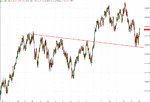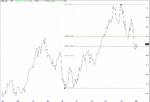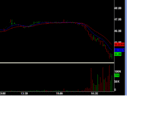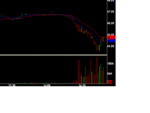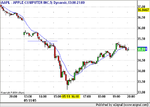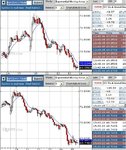You are using an out of date browser. It may not display this or other websites correctly.
You should upgrade or use an alternative browser.
You should upgrade or use an alternative browser.
Trading the US the Naz/Mr. Charts Way
- Thread starter Mr. Charts
- Start date
- Watchers 13
Naz said:It is horses for courses.
That means every day there are oppertunities to be found both long and short.So IF you can get your trading right and it can sensibly become your job and a full time occupation.
Naz
I continue to be flabbergasted by the number who fail at this sort of trading.
I'm not trying to imply that it's easy...it's not....well, the mathematics part is dead easy really.
The hard part is all the emotional/psychological rubbish which destroys our brains ability to add 2 + 2 and get 4 add at the end, or to be able to react in the time needed. Or perhaps it's the gambling mentallity that most bring to the market with them..dunno really. After 5 years doing this I still have to give myself the occasional uppercut.
Anyway this is just a long winded way concurring with Naz. Once you get these issues out of the way its a great full time occupation/business for a whole bunch of reasons. Having been involved with a few businesses in my time, I think this is the best.
Wayne
wal said:schoe,
Thanks for that, I'll look into it.
Is thare a particular piece of typing software that you can recommend?
Wayne
Hi Wayne. I used one called Mavis Beacon teaches typing but that was a few years ago I think there are probably more modern versions now.
Its one of the most useful skills I have ever learnt and helps me buy when I want to buy rather than sell when I want to buy
Mr. Charts
Legendary member
- Messages
- 7,370
- Likes
- 1,200
Fri May 6th
I couldn't do a daily thread y'day as I was away coaching an advanced live course.
The first stock was GPRO -as mentioned elsewhere on this forum - and that was a short at 44.96. When it reached 44.00 we stopped and reversed (banking 96c/share) and then closed the long at 44.73 for another + 73c.
My client took screen shots of that trade and the others y'day. He forgot to save the first shot of the initial short entry in the heat of the moment but got the stop and reverse and the final exit.
He's sent me those two which are below.
Hopefully some people will find them useful particularly in view of posts by others y'day about GPRO.
I couldn't do a daily thread y'day as I was away coaching an advanced live course.
The first stock was GPRO -as mentioned elsewhere on this forum - and that was a short at 44.96. When it reached 44.00 we stopped and reversed (banking 96c/share) and then closed the long at 44.73 for another + 73c.
My client took screen shots of that trade and the others y'day. He forgot to save the first shot of the initial short entry in the heat of the moment but got the stop and reverse and the final exit.
He's sent me those two which are below.
Hopefully some people will find them useful particularly in view of posts by others y'day about GPRO.
Attachments
Mr. Charts
Legendary member
- Messages
- 7,370
- Likes
- 1,200
On the radar today so far:
PIXR
BCSI
UTSI
SINA
ICOS
There will be others later before market open, but I won't have time to post them today.
Richard
PIXR
BCSI
UTSI
SINA
ICOS
There will be others later before market open, but I won't have time to post them today.
Richard
Mr. Charts said:On the radar today so far:
PIXR
BCSI
UTSI
SINA
ICOS
There will be others later before market open, but I won't have time to post them today.
Richard
Cheers Mr C..
Long SINA at 27.22
Closed on traling stop at 27.94 (+70 cents).
Last edited:
Short on PIXR at 49.95 (on break below $50)
Got caught on bounce back : closed at 50.23 for loss of 28 cents.
Short again PIXR at 49.75 (on break below previous support levels and after period of consolidation).
Closed at 48.70 for gain of $1.05.
The last exit was using a trailing stop all the way down.
P.S > Could well fall further if it breaks 48.50 on downside ?
Got caught on bounce back : closed at 50.23 for loss of 28 cents.
Short again PIXR at 49.75 (on break below previous support levels and after period of consolidation).
Closed at 48.70 for gain of $1.05.
The last exit was using a trailing stop all the way down.
P.S > Could well fall further if it breaks 48.50 on downside ?
Mr. Charts
Legendary member
- Messages
- 7,370
- Likes
- 1,200
The Extra Dimension
For me personally the way I use level2, bid/sell pressures, T&S provides me with the extra dimension - what I call "micro-analysis."
It gives me another additional 25% edge to add to the other patterns and methods I use.
There's a thread on the main boards called "Stop Hunting" in the Forex section.
Someone here has suggested I should re-post my comments as he thinks there are some worthwhile thoughts on it which members here might not have seen and might find useful.
http://www.trade2win.com/boards/showthread.php?t=15047
"robq has asked an interesting question which has gone unanswered so far.
There was a stock this afternoon I was about to go long on when the "large size on the bid" scenario suddenly appeared. I hit screen dump as I thought it would be a useful image for coaching reasons.
I've cropped the image and erased the stock name.
Would anybody care to say what happened next and why?
Richard
I thought I'd wait a little longer to see if anyone else wanted to have a go.
The stock was approaching its high of the day and I was looking to assess whether to go long.
When abnormally large size appeared from cinn on the bid it seemed likely to me this was someone using the ECN wanting everyone to think she was a buyer.
Now you can come up with all sorts of theories about what and why, some plausible, some not.
However, what was the actual market action that ensued? In the next few seconds the number of shares being bid for on cinn at that best bid shrunk rapidly with sells printing off on T&S. Within seconds the price fell 10c as bids were pulled/hit. Then it stabilised and lo and behold back came a big buyer on cinn again.
This time the supply on the market had dried up and the demand pushed the price up, it took off north and continued to rise a whole dollar.
So my way of using level 2 and T&S and reading bid/sell pressures - what I have referred to as micro-analysis - (and this is one very small example of many common scenarios) involves "reading" what actually happens incorporating my experience, not taking everything at face value or having a fixed "opinion" but seeing how the market reacts to different influences - and trading accordingly. It might sound complex, but it's like learning to drive. Once you know what to do and what usually happens, experience enables you to anticipate future activity with a high degree of probability - like anticipating road conditions and events before and as they start to happen.
You could say that this is BEYOND "price and volume" (and I refer specifically to trading Nasdaq shares here - nothing else) so you can often anticipate price action and volume BEFORE volume registers or any chart indicator suggests anything.
HTH
Richard
Hi peto,
"Are we saying then that it was an successful attempt at a double bluff....."
Not necessarily. She could have been a genuine buyer but there was simply too much supply on the market at that moment.
"Only trouble is most road users don't deliberately set out to confuse others"
True. Most analogies break down if pushed too far, but the point is that once you are familiar with the handful of ploys players use, then you can read the market far better. For example if you rely on charts only you might have a success rate with breakouts of say, 60%. By being able to read the market by seeing what players are doing using what I call micro-analysis you can raise your success rate to maybe 80%. This is obviously a huge edge.
"I fear that I would be caught in the headlights during the L2 learning process a little too often...."
The way to prevent that is to practice, practice, practice until you are getting it right most of the time before you trade for real. Even then you start off trading small size till consistent success and profits give you the experience and confidence to trade in size and make money.
This, in my view, is about building the skills and edge required to win. Work and application are required to succeed in most endeavours.
If micro-analysis isn't telling me a CLEAR story, I won't trade the pattern set-up. Im my trading I require one of my set ups, then the trigger.
No set up - no trade.
Set up but no trigger - no trade.
Set up plus CLEAR trigger - trade
Develop the rules, apply them.
In a sense the discretionary element is much less than people think. Again using the driving analogy, if you are about to enter a roundabout you will only do it when you can clearly see it's safe to do so.
Some would say that is exercising discretion and in a sense it is. But there are underlying indications which enable you to safely make that decision. Trading, for me, is the same.
Of course the analogy will break down when you've got people who will enter a roundabout and force traffic already in it to stop or brake. And of course you get people who will accelerate and close up a gap so you can't get in - a ploy a little like MMs. However, with experience you can usually spot those drivers and MMs and act accordingly.
Richard
__________________
Mr. Charts
US Trader and Coach
For me personally the way I use level2, bid/sell pressures, T&S provides me with the extra dimension - what I call "micro-analysis."
It gives me another additional 25% edge to add to the other patterns and methods I use.
There's a thread on the main boards called "Stop Hunting" in the Forex section.
Someone here has suggested I should re-post my comments as he thinks there are some worthwhile thoughts on it which members here might not have seen and might find useful.
http://www.trade2win.com/boards/showthread.php?t=15047
"robq has asked an interesting question which has gone unanswered so far.
There was a stock this afternoon I was about to go long on when the "large size on the bid" scenario suddenly appeared. I hit screen dump as I thought it would be a useful image for coaching reasons.
I've cropped the image and erased the stock name.
Would anybody care to say what happened next and why?
Richard
I thought I'd wait a little longer to see if anyone else wanted to have a go.
The stock was approaching its high of the day and I was looking to assess whether to go long.
When abnormally large size appeared from cinn on the bid it seemed likely to me this was someone using the ECN wanting everyone to think she was a buyer.
Now you can come up with all sorts of theories about what and why, some plausible, some not.
However, what was the actual market action that ensued? In the next few seconds the number of shares being bid for on cinn at that best bid shrunk rapidly with sells printing off on T&S. Within seconds the price fell 10c as bids were pulled/hit. Then it stabilised and lo and behold back came a big buyer on cinn again.
This time the supply on the market had dried up and the demand pushed the price up, it took off north and continued to rise a whole dollar.
So my way of using level 2 and T&S and reading bid/sell pressures - what I have referred to as micro-analysis - (and this is one very small example of many common scenarios) involves "reading" what actually happens incorporating my experience, not taking everything at face value or having a fixed "opinion" but seeing how the market reacts to different influences - and trading accordingly. It might sound complex, but it's like learning to drive. Once you know what to do and what usually happens, experience enables you to anticipate future activity with a high degree of probability - like anticipating road conditions and events before and as they start to happen.
You could say that this is BEYOND "price and volume" (and I refer specifically to trading Nasdaq shares here - nothing else) so you can often anticipate price action and volume BEFORE volume registers or any chart indicator suggests anything.
HTH
Richard
Hi peto,
"Are we saying then that it was an successful attempt at a double bluff....."
Not necessarily. She could have been a genuine buyer but there was simply too much supply on the market at that moment.
"Only trouble is most road users don't deliberately set out to confuse others"
True. Most analogies break down if pushed too far, but the point is that once you are familiar with the handful of ploys players use, then you can read the market far better. For example if you rely on charts only you might have a success rate with breakouts of say, 60%. By being able to read the market by seeing what players are doing using what I call micro-analysis you can raise your success rate to maybe 80%. This is obviously a huge edge.
"I fear that I would be caught in the headlights during the L2 learning process a little too often...."
The way to prevent that is to practice, practice, practice until you are getting it right most of the time before you trade for real. Even then you start off trading small size till consistent success and profits give you the experience and confidence to trade in size and make money.
This, in my view, is about building the skills and edge required to win. Work and application are required to succeed in most endeavours.
If micro-analysis isn't telling me a CLEAR story, I won't trade the pattern set-up. Im my trading I require one of my set ups, then the trigger.
No set up - no trade.
Set up but no trigger - no trade.
Set up plus CLEAR trigger - trade
Develop the rules, apply them.
In a sense the discretionary element is much less than people think. Again using the driving analogy, if you are about to enter a roundabout you will only do it when you can clearly see it's safe to do so.
Some would say that is exercising discretion and in a sense it is. But there are underlying indications which enable you to safely make that decision. Trading, for me, is the same.
Of course the analogy will break down when you've got people who will enter a roundabout and force traffic already in it to stop or brake. And of course you get people who will accelerate and close up a gap so you can't get in - a ploy a little like MMs. However, with experience you can usually spot those drivers and MMs and act accordingly.
Richard
__________________
Mr. Charts
US Trader and Coach
Attachments
Last edited:
Mr. Charts
Legendary member
- Messages
- 7,370
- Likes
- 1,200
The Extra Dimension enabled me to take my first trade today.
The pattern in IART pointed to a break to a new high 5 mins into trading and level 2, T&S and all the strong buy pressures and weak sell pressures told me this was a no brainer. With direct access you can be into a stock within a second and out within a second too. This means that if those "no brainer" pressures suddenly died or reversed, (this is very unlikely in this situation in my experience), I can be out very fast.
So, if it dies on you at entry you can be out for a scratch trade.
If it reverses immediately you can be out for a loss of normally 3 to 10 cents.
If it progresses, (which is the norm), you make decent money. Often very quickly.
With IART today I was in and out within 30 seconds, exiting because the buying frenzy was visibly abating.
50c move on 2000 shares is $1000 in seconds.
For someone trading 500 shares it would have been $250 or 1000 shares $500 profit.
Interestingly that candle finishing the minute I exited was the high of the day so far.
HTH
Richard
The pattern in IART pointed to a break to a new high 5 mins into trading and level 2, T&S and all the strong buy pressures and weak sell pressures told me this was a no brainer. With direct access you can be into a stock within a second and out within a second too. This means that if those "no brainer" pressures suddenly died or reversed, (this is very unlikely in this situation in my experience), I can be out very fast.
So, if it dies on you at entry you can be out for a scratch trade.
If it reverses immediately you can be out for a loss of normally 3 to 10 cents.
If it progresses, (which is the norm), you make decent money. Often very quickly.
With IART today I was in and out within 30 seconds, exiting because the buying frenzy was visibly abating.
50c move on 2000 shares is $1000 in seconds.
For someone trading 500 shares it would have been $250 or 1000 shares $500 profit.
Interestingly that candle finishing the minute I exited was the high of the day so far.
HTH
Richard
Attachments
BlackPanther
Junior member
- Messages
- 30
- Likes
- 1
AAPL's move down
Apologies if this is a silly question..
I'm fairly new to this and not yet trading. Just noticed AAPL - dropped about $2 between 10am and 11am (it's back up a bit now, to $34.64) - just out of curiosity wondering if anyone managed to catch this move? If so, was it an obvious move - or if not, other than if simply not being watched/noticed were there other reasons for not catching it?
I am (hopefully) attaching a copy of the current chart from Y! Finance for reference.
Will
Apologies if this is a silly question..
I'm fairly new to this and not yet trading. Just noticed AAPL - dropped about $2 between 10am and 11am (it's back up a bit now, to $34.64) - just out of curiosity wondering if anyone managed to catch this move? If so, was it an obvious move - or if not, other than if simply not being watched/noticed were there other reasons for not catching it?
I am (hopefully) attaching a copy of the current chart from Y! Finance for reference.
Will
Attachments
wsimmonds said:Apologies if this is a silly question..
I'm fairly new to this and not yet trading. Just noticed AAPL - dropped about $2 between 10am and 11am (it's back up a bit now, to $34.64) - just out of curiosity wondering if anyone managed to catch this move? If so, was it an obvious move - or if not, other than if simply not being watched/noticed were there other reasons for not catching it?
I am (hopefully) attaching a copy of the current chart from Y! Finance for reference.
Will
I managed to short pre market @ 35.45 only for it to spike back up and take me out. When I went back to look later I had missed the break of $35.00 so I waited a bit and caught a scalp for a few bucks later on when it bounced.
Cant win em all.
🙄
Attachments
Mr. Charts
Legendary member
- Messages
- 7,370
- Likes
- 1,200
Sorry not to be posting much at the moment but I'm very busy with coaching, my normal trading and a new project - all eating up lots of time.
I'll post whenever I can and will try and manage a few contributions a week.
Richard
I'll post whenever I can and will try and manage a few contributions a week.
Richard
Mr. Charts
Legendary member
- Messages
- 7,370
- Likes
- 1,200
Nice one, Achilles, well spotted.
Richard
Richard
jitasb said:Good trade Mr Boy ...looks like your exit was spot on. 🙂
P.S Looks like a nice reversal as well ...did anyone go long ?
No, but I was going to......honest!
😆
Mr. Charts
Legendary member
- Messages
- 7,370
- Likes
- 1,200
Nice trading, boy,
The natural reaction to making a lot of money on a short and getting out on the reversal, is to relax a bit - go put the kettle on - grin a lot.
Fatal as you then look back and see a classic bounce follow through ;-)
Richard
The natural reaction to making a lot of money on a short and getting out on the reversal, is to relax a bit - go put the kettle on - grin a lot.
Fatal as you then look back and see a classic bounce follow through ;-)
Richard
Similar threads
- Replies
- 134
- Views
- 27K
- Replies
- 18
- Views
- 4K
- Replies
- 6
- Views
- 4K

